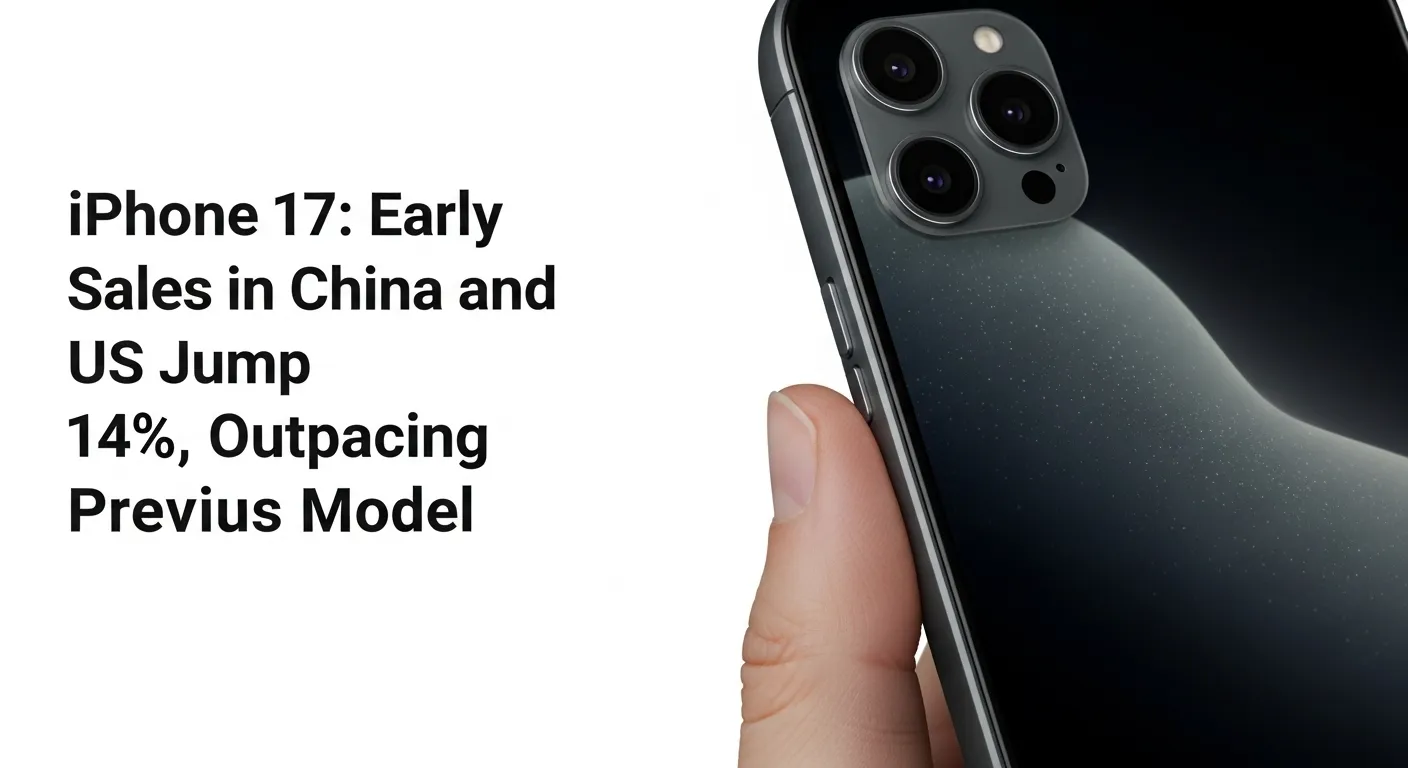iPhone 17: Early Sales in China and US Jump 14%, Outpacing Previous Model
When the iPhone 17 hit stores, something noteworthy happened: early sales in the United States and China jumped by about 14% compared with its predecessor, the iPhone 16. That may sound like a simple number, but for a company like Apple Inc. (Apple) in the smartphone business, it signals a strong shift. We look at how and why this boost occurred, what changed in the product and market, and what it could mean going forward.
Global Sales Performance at Launch
The key fact: Apple’s base model iPhone 17 sold 14% more in its first ten days in the U.S. and China than the iPhone 16 did during its comparable launch period. In China, early sales of the base model nearly doubled those of the prior model. Also, according to market-data firm IDC, Apple’s shipments in China in Q3 2025 rose slightly by 0.6% to 10.8 million units, even though the overall Chinese smartphone market fell 0.6 %.
So what we’re seeing is growth in key markets at a time when many others are declining. That sets the scene for Apple’s momentum.
Strong Demand in the United States
In the U.S., for many buyers, the iPhone 17 stood out as a compelling upgrade. The early demand suggests that trade-in offers, carrier deals, and strong brand loyalty combined to drive sales. Reports show that the base model (which carries a lower price than the high-end Pro versions) gained particular traction.
We see that many existing iPhone users are willing to upgrade now, perhaps because last year they held off. The “value equation” appears better with this generation: enhanced specs for similar pricing. News outlets noted how Apple’s stock market reaction was positive after the report of strong early sales.
Carrier partnerships likely helped. Incentives such as trade-in credits, zero-down finance, and bundled offers made it easier to upgrade. While we may not have a full breakdown yet, the signals are clear: the U.S. customer base is responding.
China Sales Rebound
China has been a challenging market for Apple in recent years. In 2024, the company lost market share there, falling to third place amid strong competition from local brands. But with the iPhone 17, Apple appears to have turned things around. The base model’s sales nearly doubled in China compared to its predecessor in the same time window. IDC’s data backs this up: Apple was the only one of the top three vendors in China to post growth in Q3 while others declined.
Why is this important? China is a massive market for smartphones and for Apple’s revenue. A rebound there means Apple is regaining strength, and may reduce pressure from domestic rivals who have been grabbing share.
What’s Driving the 14% Growth?
Several factors appear to converge. Let us list them:
- Hardware upgrades: The iPhone 17 features an improved display, higher base storage (e.g., starting at 256 GB rather than 128 GB), and the new Apple A19 chip. These upgrades are noted in multiple sources as key to driving consumer interest.
- Same price point, better specs: What stands out is that Apple did not dramatically raise the starting price of the base model, while offering meaningful improvements. That strengthens the value proposition.
- Promotions and trade-in programs: Though less rigorously quantified, industry commentary suggests Apple and its carriers stepped up offers to push upgrades, especially in the U.S. and China. Trade-in credits offset cost, helping consumers decide sooner.
- Pent-up demand: Many smartphone users delayed upgrading in recent years, thanks to slower innovation cycles and macro-economic pressures. With the iPhone 17 offering more visible gains, customers may feel now is the right moment.
- Marketing and brand push: Apple’s positioning of the iPhone 17 as a meaningful upgrade, combined with in-store events and pre-order buzz, helped generate momentum. For example, during the global launch, lines appeared in major cities.
Together, these factors form a strong mix of supply, demand, value, and timing.
Consumer Behavior and Market Sentiment
Who’s buying? Early indications suggest both long-time iPhone users and switchers from other brands are participating. For users on older iPhone models (e.g., iPhone 11 or iPhone 12), the upgrades feel more meaningful now: faster chip, improved camera, better battery, larger storage. Social media, tech analysts, and influencers have noted that the “upgrade itch” is stronger for those who held off last year.
We also see that Apple’s ecosystem continues to play a role. Many consumers stick with Apple devices not just for the phone but for integration with other Apple hardware and services. That ecosystem lock-in gives Apple an advantage.
In terms of sentiment, investors and markets reacted positively to the early sales figures. For a company that relies heavily on the iPhone for revenue, this kind of beat is reassuring.
Comparison with iPhone 16 Launch
Let’s look at how things differ:
- With the iPhone 16 launch, growth was modest, and the market already showed signs of saturation.
- Replacement cycles had lengthened: users were keeping phones longer.
- In contrast, the iPhone 17 now offers more tangible upgrades and value, making the decision to buy more compelling.
- Market conditions: The smartphone market globally has been under pressure, especially in China. Yet Apple posted growth, which is noteworthy.
By comparing the two launches, we see Apple appears to have addressed some of the hurdles that slowed the previous model’s performance.
Economic and Industry Impact
What does this mean for Apple’s business?
- The iPhone remains a major driver of Apple’s revenue. A strong launch helps the company meet or exceed guidance, which in turn supports stock performance and investor confidence.
- With stronger shipments in China (even when the overall market fell), Apple may capture more share and deliver better margins versus local competitors.
- For the smartphone industry, Apple’s success puts pressure on other manufacturers to ramp up innovation, offers, and marketing. Brands like Huawei, Xiaomi, and others must respond.
- On a macro level, consumer spending on high-end devices may signal better sentiment, or at least willingness to invest in premium hardware. That has knock-on effects across supply chains, chipmakers, and app ecosystems.
In short: a strong iPhone 17 launch could fuel upward momentum not just for Apple but for its broader supply network.
Challenges Still Ahead
Even with the strong start, Apple faces hurdles:
- Supply chain and production: Global manufacturing remains complex. Any hiccup (e.g., component shortages, logistics delays) could hamper supply and frustrate consumers.
- Competitive pressure: Especially in China and emerging markets, local brands offer strong value and increasingly advanced features. Maintaining growth will require more than just incremental improvements.
- Economic and consumer environment: Inflation, economic slowdown, and shifting priorities mean some consumers may delay upgrades. Apple must keep its offers compelling.
- Innovation expectations: With every year bringing more hype (AI, AR/VR, etc.), the pressure is on Apple to deliver major steps, especially since rivals are already marketing bold features.
We must remember: early sales are great, but sustaining momentum across quarters is more challenging.
Outlook for the Coming Quarters
What might we expect?
- If this early surge continues, Apple could see a strong holiday quarter, traditionally its largest. The iPhone 17 is well-positioned heading into the season.
- Apple is likely to expand availability, push more regional marketing, and perhaps offer new colors or storage tiers to keep interest high.
- We may also see more emphasis on services tied to the iPhone ecosystem (e.g., Apple One, Apple Fitness+, etc.), which boost recurring revenue.
- On the hardware front, attention will turn to the next upgrade cycle and whether Apple makes larger leaps (for example, integrating more advanced AI features) to keep ahead of the competition.
In short, if Apple plays well, the iPhone 17 could set the stage for several strong quarters.
Conclusion
So, what’s the takeaway? The iPhone 17’s strong early sales, up ~14% in key markets compared to its predecessor, tell us something important: Apple has regained momentum. In both the U.S. and China, the base model is resonating with users due to better specs, consistent pricing, and smart launch timing. For Apple, this means not just a successful product launch, but a potential inflection point in its flagship business. For consumers and competitors alike, it means the smartphone race remains very much alive.
As we move forward, we’ll be watching whether Apple can sustain this momentum, expand into new markets, and keep pushing the value envelope. If the iPhone 17 is any indication, the company is off to a strong start.
Disclaimer:
This content is for informational purposes only and is not financial advice. Always conduct your research.






